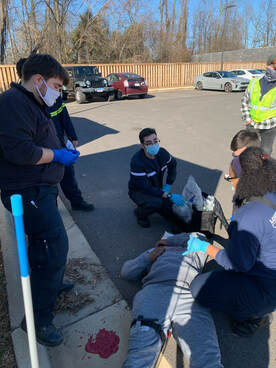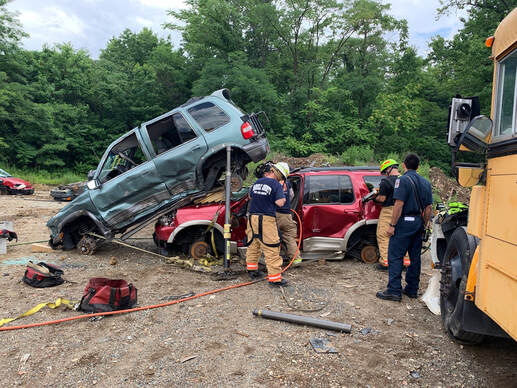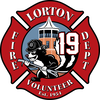Training
The certification process to become an operational volunteer is deeply rewarding and requires commitment and dedication over the course of months and years. For volunteers with no prior experience, training can take between 6–18 months. For applicants with prior experience or certifications it may be possible to transfer their certifications into Fairfax County and shorten the process. To become a competent provider, volunteers must also spend time riding on fire engines and ambulances during emergencies while continuously practicing, maintaining and improving their skills. This is the reason for our volunteer's being expected to serve a minimum of 240 hours per year, but many choose to volunteer for over 1,000 hours. Operational volunteers must attend introductory and ongoing refresher classes and be in good physical condition.
All Volunteers:
All operational volunteers are required to attend VISIT and Level I trainings prior to beginning any further classes in either EMS or Fire Suppression. The completion of this level of the training can take between 1–3 months. During this time you will also be expected to schedule and complete a physical exam and drug screening in order to qualify for EMT school and Fire school.
Volunteer In-Station Initiation Training (VISIT) – This is an in-station orientation program to familiarize new members with the fire station, equipment, procedures, rules, opportunities, and staff. Expect around 5 hours of total instruction and study.
Level I – Also known as Initial Emergency Response Training, Level 1 is taught at the Fairfax County Fire and Rescue Department Training Academy, located in the Fair Oaks area. The course gives new volunteers an introduction to the world of emergency services and details the operations of the Fairfax County Fire and Rescue Department as a whole. Volunteers will also learn basic emergency provider skills such as CPR, Hazardous Materials Awareness, Communications, and the use of a fire extinguisher. Such initial training enables new volunteers to ride as an observer on ambulances and fire engines. Duration: 30 days. Evening classes are held during weekday evenings with occasional classes held on Saturday or Sunday mornings. Expect around 40 hours of total instruction and study.
Physical Exam – A thorough physical will be conducted at the Fairfax County Occupational Health and Safety Center. This exam tests provisional volunteers’ ability to handle the stresses of being an emergency services provider. A passing physical is required in order to continue volunteer training and participate as an operational volunteer. The physical exam includes immunization checks, a basic physical, a treadmill stress test, and a urine drug screening.
Volunteer In-Station Initiation Training (VISIT) – This is an in-station orientation program to familiarize new members with the fire station, equipment, procedures, rules, opportunities, and staff. Expect around 5 hours of total instruction and study.
Level I – Also known as Initial Emergency Response Training, Level 1 is taught at the Fairfax County Fire and Rescue Department Training Academy, located in the Fair Oaks area. The course gives new volunteers an introduction to the world of emergency services and details the operations of the Fairfax County Fire and Rescue Department as a whole. Volunteers will also learn basic emergency provider skills such as CPR, Hazardous Materials Awareness, Communications, and the use of a fire extinguisher. Such initial training enables new volunteers to ride as an observer on ambulances and fire engines. Duration: 30 days. Evening classes are held during weekday evenings with occasional classes held on Saturday or Sunday mornings. Expect around 40 hours of total instruction and study.
Physical Exam – A thorough physical will be conducted at the Fairfax County Occupational Health and Safety Center. This exam tests provisional volunteers’ ability to handle the stresses of being an emergency services provider. A passing physical is required in order to continue volunteer training and participate as an operational volunteer. The physical exam includes immunization checks, a basic physical, a treadmill stress test, and a urine drug screening.
Emergency Medical Technician (EMT)

EMT-B School – This is a Virginia EMT-B (basic) certification course meeting national standards laid out by the U.S. Department of Transportation. This course provides the knowledge and skills needed to provide basic life support (BLS) care and to function independently in a medical emergency. Students learn how to take vital signs, properly stabilize patients, deliver babies, and treat traumatic injuries or life-threatening medical emergencies in a pre-hospital setting.
Duration: 6 months. Classes are held at the Fire and Rescue Academy on Tuesday and Thursday nights and Sunday mornings. 120 hours of total classroom instruction.
Emergency Vehicle Operators Course (EVOC) – EVOC teaches volunteers the fundamentals of emergency vehicle operations, including applicable laws and safety procedures. This qualification is required before being allowed to drive apparatus in emergency conditions.
Expect 12 hours of total classroom instruction and testing over the course of 3 months.
After completing the basic EMS training process volunteers are encouraged to attend advanced training including: Fire School, unit officer training, and Paramedic School. These programs allow experienced volunteers to enhance their skills and assume more responsibility during emergencies, while improving their ability to support their community on a daily basis. Those volunteers who have chosen to pursue these opportunities reflect the skill, commitment, and professionalism of The Lorton Volunteer Fire Department's fire and rescue volunteers.
Duration: 6 months. Classes are held at the Fire and Rescue Academy on Tuesday and Thursday nights and Sunday mornings. 120 hours of total classroom instruction.
Emergency Vehicle Operators Course (EVOC) – EVOC teaches volunteers the fundamentals of emergency vehicle operations, including applicable laws and safety procedures. This qualification is required before being allowed to drive apparatus in emergency conditions.
Expect 12 hours of total classroom instruction and testing over the course of 3 months.
After completing the basic EMS training process volunteers are encouraged to attend advanced training including: Fire School, unit officer training, and Paramedic School. These programs allow experienced volunteers to enhance their skills and assume more responsibility during emergencies, while improving their ability to support their community on a daily basis. Those volunteers who have chosen to pursue these opportunities reflect the skill, commitment, and professionalism of The Lorton Volunteer Fire Department's fire and rescue volunteers.
Firefighter

After you have completed EMT school, you may begin the process of becoming a Firefighter. This process consists of training for, and then passing, a physical ability test and then completing the rigorous 5 months of Fire School. It is important to remember that you must be granted "Class A" status on your physical and stress test in order to be medically authorized for Fire School.
Physical Abilities Test (CPAT) – CPAT is designed to test whether recruits are physically able to perform essential physical skills often required during firefighting operations. The test consists of eight separate skills that must be performed in sequence, within 10 minutes 20 seconds. To learn more about the Fairfax County CPAT, view this Overview and Training Guide.
Firefighter I/II Class – Firefighter I/II is a national certification course that teaches the basics of firefighting and exceeds the standards for the National Fire Prevention Association’s Standard for Firefighter Professional Qualifications. Students learn skills including ropes and knots, ladders, search and rescue, fire behavior, fire suppression, vehicle extrication, high-rise firefighting, hazardous material operations, and more.
Duration: 8 months. Classes at the Fire and Rescue Academy on Tuesday and Thursday nights, as well as all day on Saturdays and Sundays. Expect 300+ hours of classroom and practical instruction.
After the successful completion of Fire School volunteers may begin to ride fire engines and ambulances in their role as volunteer EMT/Firefighter. They are also encouraged to advance their education and improve their skills by becoming paramedics, engine drivers, unit officers, instructors, swift water rescue technicians, technical rescue technicians, hazardous materials technicians, and command officers. These programs allow experienced volunteers to enhance their skills and assume more responsibility during emergencies. While this is a time intensive and challenging process those who are committed to improve themselves and supporting their community find the process to be incredibly rewarding.
Physical Abilities Test (CPAT) – CPAT is designed to test whether recruits are physically able to perform essential physical skills often required during firefighting operations. The test consists of eight separate skills that must be performed in sequence, within 10 minutes 20 seconds. To learn more about the Fairfax County CPAT, view this Overview and Training Guide.
Firefighter I/II Class – Firefighter I/II is a national certification course that teaches the basics of firefighting and exceeds the standards for the National Fire Prevention Association’s Standard for Firefighter Professional Qualifications. Students learn skills including ropes and knots, ladders, search and rescue, fire behavior, fire suppression, vehicle extrication, high-rise firefighting, hazardous material operations, and more.
Duration: 8 months. Classes at the Fire and Rescue Academy on Tuesday and Thursday nights, as well as all day on Saturdays and Sundays. Expect 300+ hours of classroom and practical instruction.
After the successful completion of Fire School volunteers may begin to ride fire engines and ambulances in their role as volunteer EMT/Firefighter. They are also encouraged to advance their education and improve their skills by becoming paramedics, engine drivers, unit officers, instructors, swift water rescue technicians, technical rescue technicians, hazardous materials technicians, and command officers. These programs allow experienced volunteers to enhance their skills and assume more responsibility during emergencies. While this is a time intensive and challenging process those who are committed to improve themselves and supporting their community find the process to be incredibly rewarding.
